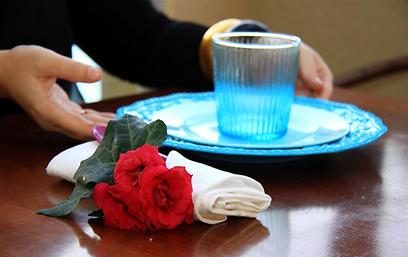Twelve years ago, when she was a 28-year-old newlywed, Elisheva Gliksberg's world fell apart.
"Someone hit me from the back. I heard a loud boom and was certain that my life was over," she recalls. Luckily, she stayed alive but the injury was serious and included damage to her neck and spine. "For 18 months I had to lie on the floor in a dark room with closed windows, squirming in agony caused by permanent headaches."
Gliksberg, who is known today as the ultra-Orthodox's public's design and styling guru and was at the time the wife of a yeshiva student and the daughter-in-law of the legendary chief rabbi of Givatayim, Rabbi Yosef Gliksberg, was seriously injured in a road accident.
Religion and Femininity
Interest in women's fashion rapidly growing within Israel's religious Zionist movement, with ever-growing number of shops, specialist designers entering field
During that period she also gave birth to her daughter. "My mother raised her. I suffered from balance difficulties and couldn't hold the baby. Up till then I was very in control, life smiled at me, and after the accident I suddenly felt like God was laughing at me. I was 29 and felt like I had lost faith in everything."
Gliksberg became addicted to painkillers and was filled with self-pity. "One day I began thinking, there is Providence in the world and I am a believer. I've received so many gifts, why despair?"
And who helped you up?
"My husband. He said, "You must take the first step. If you fall, I'll pick you up.' I realized that in order to get out of the dark room I would have to take action. I decided to establish an event design school in the haredi sector. That was in 2002. I posted an ad, and for 10 months nobody called. Then the first young woman called and turned me into a teacher.
"Today, the students of the 34th class are studying in the school, which is located in Bnei Brak bordering Ramat Gan. More than 1,500 women and girls from the haredi sector all over Israel have already passed the different courses in the field of event initiation and production. Over time we added home styling of the domestic environment and styling of the commercial environment," says Gliksberg.
"The design marathons we hold every Hanukkah and during the summer vacations are also attended by women from Europe and the United States."

Setting Shabbat table (Photo: Dana Kopel)
Who are the students?
"About 60% come out of curiosity and out of love for the field of design and out of a desire to invest in events and entertainment. After all, for quite a lot of women in the sector, every Shabbat and holiday table is a sort of celebration. The wealthy ones even rent equipment, chair covers and furniture for holiday meals at their private homes, mainly on the Seder night. Others come to acquire a profession."
And can one work in this field?
"Many of the graduates are working in this profession full-time, and there are also teachers or secretaries who design several events a month and increase the family income. In one family the children, yeshiva and seminary students, collected money and paid for the course so that their mother could fulfill her dream and study design.
"And there is also a kindergarten teacher from Mea Shearim who got married at the age of 17, saved every penny and passed the course. Today she is a designer in the sector, as is the daughter of a rebbe, who works as a school principal and designs display windows as a side job."
Good-looking woman, handsome utensils
Gliksberg, who also has a popular blog, a segment on Radio Kol Chai and design columns in haredi magazines, agrees that precisely in light of the financial situation which requires people to live more economically, her services are on high demand. This also led to an idea for a book on setting Shabbat and holiday tables and birthday tables at any budget.
"It's true," she says. "People are moving to cheaper banquet halls, holding more events at home, and it's enough to have a designer who settles for little in order to upgrade an event with a modest budget. The haredi press has also started dealing with design issues and that raises interest."
You're married to a rabbi and you're a rabbi's daughter-in-law. Do a rabbi's wife and designer go together?
"In Judaism, which respects a good-looking woman and handsome utensils, aesthetics is part of our essence as women. After all, when the messiah arrives, the Jewish women will be the ones to prepare the ornamental curtain covering the front of the Holy Ark for the Temple.
"We should remember that 'Shulchan Aruch' – the basic code of Jewish Law – engages in what is known today as 'design,' atmosphere, and it says that 'handsome utensils which are not needed for the meal will be set aside.'
"It's true that I am married to a rabbi, but quite often my husband delivers a Talmud lesson while I design a table."
And what next?
"Tours for haredi women to design centers in Europe. Mainly classic Europe – Belgium, Germany, Holland. I'll take women with me to design exhibitions in places where we can combine a professional tour, strictly kosher accommodation and practical work in workshops.
"I plan to team up with a tourism company specializing in the sector and combine visits to tombs of the just into the tours."















